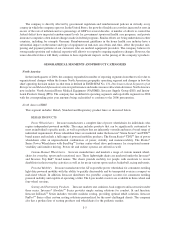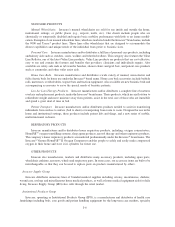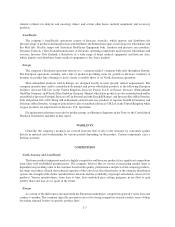Invacare 2006 Annual Report Download - page 19
Download and view the complete annual report
Please find page 19 of the 2006 Invacare annual report below. You can navigate through the pages in the report by either clicking on the pages listed below, or by using the keyword search tool below to find specific information within the annual report.products; provisions in our bank credit agreements or other debt instruments that may prevent or delay a change in
control; the loss of the services of our key management and personnel; decreased availability or increased costs of
raw materials could increase our costs of producing our products; inability to acquire strategic acquisition
candidates because of limited financing alternatives; risks inherent in managing and operating businesses in many
different foreign jurisdictions; exchange rate fluctuations, as well as the risks described from time to time in
Invacare’s reports as filed with the Securities and Exchange Commission. Except to the extent required by law, we
do not undertake and specifically decline any obligation to review or update any forward-looking statements or to
publicly announce the results of any revisions to any of such statements to reflect future events or developments or
otherwise.
Item 1A. Risk Factors.
The company’s business, operations and financial condition are subject to various risks and uncertainties. You
should carefully consider the risks and uncertainties described below, together with all of the other information in
this annual report on Form 10-K and in the company’s other filings with the SEC, before making any investment
decision with respect to the company’s securities. The risks and uncertainties described below may not be the only
ones the company faces. Additional risks and uncertainties not presently known by the company or that the
company currently deems immaterial may also affect the company’s business. If any of these known or unknown
risks or uncertainties actually occur or develop, the company’s business, financial condition, results of operations
and future growth prospects could change.
Changes in government and other third-party payor reimbursement levels and practices have negatively
impacted and could continue to negatively impact the company’s revenues and profitability.
The company’s products are sold through a network of medical equipment and home health care providers,
extended care facilities, hospital and HMO-based stores, and other providers. Many of these providers (the
company’s customers) are reimbursed for the products and services provided to their customers and patients by
third-party payors, such as government programs, including Medicare and Medicaid, private insurance plans and
managed care programs. Many of these programs set maximum reimbursement levels for some of the products sold
by the company in the United States. If third-party payors deny coverage, make the reimbursement process or
documentation requirements more uncertain or further reduce their current levels of reimbursement (i.e., beyond the
reductions described below), or if the company’s costs of production increase faster than increases in reimburse-
ment levels, the company may be unable to sell the affected product(s) through its distribution channels on a
profitable basis.
Reduced government reimbursement levels and changes in reimbursement policies have in the past added, and
could continue to add, significant pressure to the company’s revenues and profitability. In early 2006, CMS
announced a series of changes to the eligibility, documentation, codes, and payment rules relating to power
wheelchairs that impact the predictability of reimbursement of expenses for and access to power wheelchairs. The
implementation of these changes will not be completed until early in 2007, after which the effect of these changes
on the company’s business will become more apparent. However, these changes may be significant. Effective
November 15, 2006, the CMS reduced the maximum reimbursement amount for power wheelchairs under Medicare
by up to 28%. The reduced reimbursement levels may cause consumers to choose less expensive versions of the
company’s power wheelchairs. Additionally, the Deficit Reduction Act of 2005 includes payment cuts for home
oxygen equipment that will take effect in 2009 and reductions for certain durable home medical equipment
spending that will take effect in 2007.
Largely as a consequence of the announced reimbursement reductions and the uncertainty created thereby,
North American net sales were lower in 2006 as compared to 2005 as were Asia/Pacific sales as the U.S. reim-
bursement uncertainty in the power wheelchair market, resulted in decreased sales of microprocessor controllers by
the company’s Dynamic Controls subsidiary. Sales of respiratory products were particularly affected by the
changes. Small and independent provider sales declined as these dealers slowed their purchases of the company’s
HomeFill
TM
oxygen system product line, in part, until they had a clearer view of future oxygen reimbursement
levels. Furthermore, a study issued by the Office of Inspector General or “OIG,” in September 2006
I-15
























